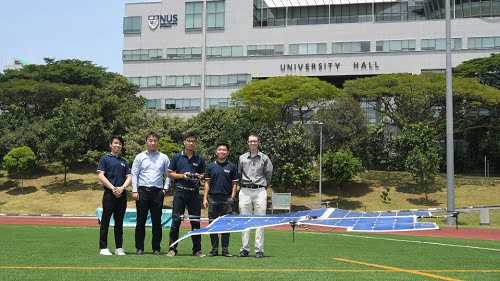
NUS Team Enables Solar-Powered Drone Flight
SINGAPORE, Sept. 25, 2018 — A team from the National University of Singapore (NUS) has achieved a major step forward in stretching the capabilities of quadcopter drones by powering the flight solely by natural sunlight.

The quadcopter drone developed by the NUS engineering team can be powered solely by sunlight and has flown above 10 meters in test flights. Courtesy of NUS.
A first in Asia, the current prototype has flown >10 m in test flights, utilizing solar power with no battery or other energy storage on board. The solar-powered drone, which was developed as a student project under the Innovation & Design Program at NUS, can take off and land vertically without a runway. Constructed using lightweight carbon fiber material, the quadcopter drone weighs 2.6 kg and has a 4-sq-m surface area. It is fitted with 148 individually characterized silicon solar cells and supported by a frame equipped with four rotors.
Rotary-winged aircraft are significantly less efficient at generating lift compared to their fixed-wing counterparts. While there have been examples of solar airplanes in recent years, a viable 100 percent solar rotary aircraft that can take off and land vertically remains a major engineering challenge.
“Our aircraft is extremely lightweight for its size, and it can fly as long as there is sunlight, even for hours,” said Aaron Danner, associate professor at NUS and project supervisor. “Unlike conventional quadcopter drones, our aircraft does not rely on on-board batteries and hence it is not limited by flight time. Its ability to land on any flat surface and fly out of the ground effect in a controlled way also makes it suitable for practical implementation.”
The solar-powered quadcopter drone can be controlled by remote control or programmed to fly autonomously using a GPS system incorporated into the aircraft. The aircraft can potentially be used as a flying solar panel to provide emergency solar power to disaster areas, as well as for photography, small package delivery, surveillance, and inspection. Batteries can be incorporated to power the aircraft when there is no sunlight or for charging to take place during flight to enable operation when it is cloudy or dark. Other hardware such as cameras can also be included for specific applications.
“To be able to make something fly under control for a long time is a very complex engineering problem,” said project supervisor Brian Shohei Teo. “Our students have attained flight in its purest form, powered by natural sunlight. This is an amazing achievement.”
The team will continue to fine-tune the aircraft to further improve its efficiency and bring the technology closer to commercialization.
Published: September 2018